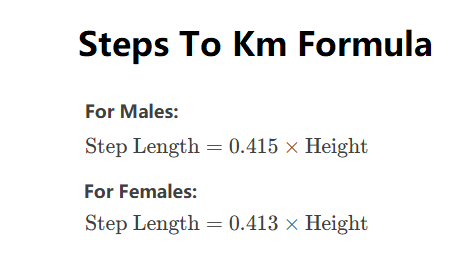1. What is a Steps to Kilometers Calculator?
Definition: This calculator converts the number of steps you’ve taken into a distance in kilometers and miles, estimating stride length based on gender, height, or user input.
Purpose: It helps walkers and runners estimate the distance they’ve covered when tracking steps, useful for fitness tracking and goal setting.
2. How Does the Calculator Work?
The calculator uses the following formulas to compute distance:
Stride Length Estimation:
- Average: 78 cm (male), 70 cm (female)
- Based on Height: \( \text{Stride Length (cm)} = \text{Height (cm)} \times 0.415 \, (\text{male}) \) or \( 0.413 \, (\text{female}) \)
- User Input: Provided value, converted to cm if in inches
Distance in Kilometers:
\( \text{Distance (km)} = \text{Number of Steps} \times \text{Stride Length (km)} \)
Where:
- Stride Length (km) = Stride Length (cm) ÷ 100,000
Distance in Miles:
\( \text{Distance (miles)} = \text{Distance (km)} \times 0.621371 \)
Steps:
- Select your Gender (Male or Female).
- Choose how to estimate your stride length (Average, Height, or User Input).
- Enter your Height or Stride Length if applicable.
- Enter the Number of Steps you’ve taken.
- Validate inputs (steps, height, stride length must be positive).
- Estimate stride length based on the selected method.
- Calculate the distance in kilometers and convert to miles.
- Display the distances in km and miles.
3. Importance of Steps to Distance Calculations
These calculations are crucial for:
- Fitness Tracking: Converts step counts into meaningful distances for monitoring daily activity.
- Goal Setting: Helps set distance-based goals when using a pedometer or fitness tracker.
- Training Planning: Assists runners and walkers in planning routes or workouts based on step counts.
4. Using the Calculator
Example 1: A female takes 10,000 steps, using average stride length:
- Gender: Female
- Estimate Based On: Average Stride Length (70 cm)
- Number of Steps: 10,000
- Stride Length: 70 cm = \( 70 \div 100,000 = 0.0007 \, \text{km} \)
- Distance (km): \( 10,000 \times 0.0007 = 7.00 \, \text{km} \)
- Distance (miles): \( 7.00 \times 0.621371 \approx 4.35 \, \text{miles} \)
Example 2: A male takes 5,000 steps, using height of 170 cm:
- Gender: Male
- Estimate Based On: Height (170 cm)
- Number of Steps: 5,000
- Stride Length: \( 170 \times 0.415 \approx 70.55 \, \text{cm} \)
- Stride Length (km): \( 70.55 \div 100,000 = 0.0007055 \, \text{km} \)
- Distance (km): \( 5,000 \times 0.0007055 \approx 3.53 \, \text{km} \)
- Distance (miles): \( 3.53 \times 0.621371 \approx 2.19 \, \text{miles} \)
5. Frequently Asked Questions (FAQ)
Q: How does gender affect stride length?
A: On average, males have a longer stride length (78 cm) than females (70 cm) due to differences in height and leg length, though this varies by individual.
Q: Why estimate stride length based on height?
A: Stride length is often proportional to height, providing a more personalized estimate than a generic average, especially when exact stride data isn’t available.
Q: How accurate is this calculation?
A: The calculation is accurate given a consistent stride length, but actual distances may vary due to changes in stride during activity or terrain differences.
Steps to Kilometers Calculator© - All Rights Reserved 2025
 Home
Home
 Back
Back
